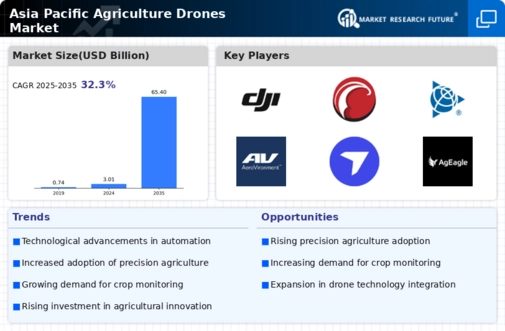Labor Shortages
Labor shortages in the agricultural sector are becoming increasingly pronounced in the Asia Pacific region, driving the adoption of drones. As the workforce ages and younger generations show less interest in farming, the need for efficient solutions becomes critical. Drones can perform tasks such as planting, spraying, and monitoring crops, effectively compensating for the lack of available labor. The Asia Pacific Agriculture Drones Market is likely to benefit from this trend, as farmers seek to automate processes and reduce reliance on manual labor. This shift not only enhances operational efficiency but also allows for the cultivation of larger areas, thereby potentially increasing overall agricultural output.
Increased Crop Yields
The Asia Pacific Agriculture Drones Market is witnessing a surge in demand due to the increasing need for enhanced crop yields. Drones equipped with advanced imaging technology can monitor crop health, assess soil conditions, and optimize irrigation practices. This precision agriculture approach allows farmers to make data-driven decisions, potentially increasing yields by up to 20%. As food security becomes a pressing concern in the region, the adoption of drones is likely to rise, enabling farmers to maximize productivity while minimizing resource use. The integration of drones into agricultural practices not only supports higher yields but also aligns with the broader goals of sustainable farming, making it a pivotal driver in the Asia Pacific Agriculture Drones Market.
Government Initiatives and Support
Government initiatives aimed at promoting technological adoption in agriculture are playing a crucial role in the Asia Pacific Agriculture Drones Market. Various governments are implementing policies and providing financial incentives to encourage farmers to adopt drone technology. These initiatives often include subsidies for purchasing drones, training programs for farmers, and research funding for developing new applications. Such support not only facilitates the integration of drones into agricultural practices but also fosters innovation within the sector. As these government-backed programs gain traction, they are likely to stimulate growth in the Asia Pacific Agriculture Drones Market, making it a key driver of market expansion.
Cost Reduction in Farming Operations
The Asia Pacific Agriculture Drones Market is significantly influenced by the potential for cost reduction in farming operations. Drones can streamline various agricultural processes, such as crop monitoring and pesticide application, which traditionally require substantial labor and resources. By utilizing drones, farmers can reduce operational costs by up to 30%, as these devices enable precise application of inputs, minimizing waste. Furthermore, the data collected by drones can lead to better resource management, further driving down costs. As farmers increasingly recognize the financial benefits of drone technology, the market is expected to expand, reflecting a growing trend towards more economically viable farming practices.
Rising Demand for Precision Agriculture
The increasing demand for precision agriculture is a significant driver in the Asia Pacific Agriculture Drones Market. Farmers are increasingly seeking methods to enhance efficiency and productivity while minimizing environmental impact. Drones provide valuable data on crop health, soil conditions, and weather patterns, enabling farmers to make informed decisions. This shift towards precision agriculture is expected to grow, with the market projected to reach USD 1.5 billion by 2027. As farmers recognize the benefits of data-driven farming, the adoption of drones is likely to accelerate, positioning the Asia Pacific Agriculture Drones Market as a leader in agricultural innovation.
















Leave a Comment